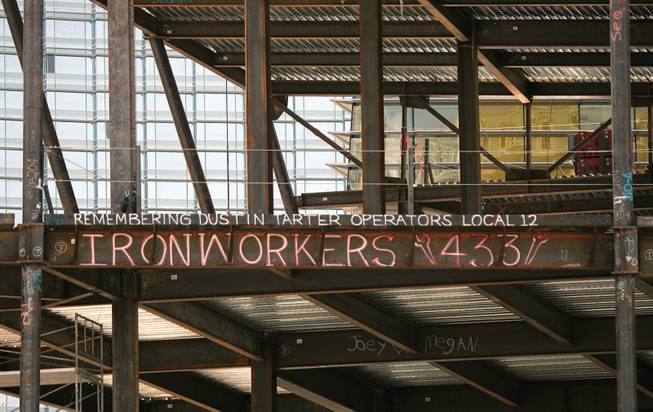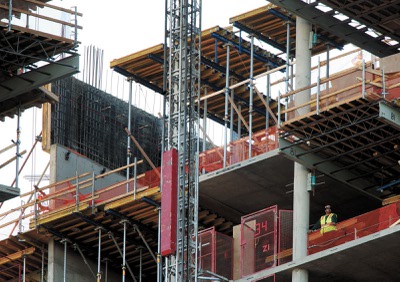
steve marcus / las vegas sun file
After crane operator Dustin Tarter died in June, workers at CityCenter painted a memorial on a beam of the project. A safety inspection followed his death, and general contractor Perini Building Co. is still appealing some of the findings.
Sunday, Dec. 14, 2008 | 2 a.m.
In Today's Sun
Sun Topics
State and federal safety inspectors found 42 serious violations last summer during a sweeping review of the CityCenter construction site that followed a string of fatalities there, a review of recently released documents shows.
The reports by the federal Occupational Safety and Health Administration reveal a pattern of improper fall protection systems, flammable materials stored incorrectly, risks of electrical shock, faulty equipment and problematic record-keeping. The conditions prevailed at various parts of the site and in projects run by subcontractors as well as general contractor Perini Building Co.
Many were violations commonly spotted by OSHA on construction sites and some were later reduced or removed in settlement deals, or are still under appeal by employers.
The inspections began in June after Dustin Tarter, a crane operator, became the sixth worker to die at CityCenter.
His death was the final straw for construction crews. They walked off the job, shutting down the $9.2 billion project for a day to protest safety conditions.
Workers said the site, the largest commercial project in the country, was overwhelming in size and crowding and in the speed and complexity of the activity. They said Perini was not doing enough to ensure safe conditions.
Perini has insisted it is doing everything it can to make CityCenter safe, and has said the deaths were the results of individual workers’ mistakes.
Perini’s efforts to increase safety on the site include marketing campaigns to educate workers about the importance of following safety rules. The company says it upholds a “zero tolerance” policy for safety violations and fires workers who break the rules. In addition, Perini is providing 10 hours of safety training to workers.
Perini would not comment on the OSHA reports because the company is still appealing some of the findings, a Perini spokeswoman said.
Nevada safety officials allowed the federal agency to help with the site inspection because the state’s staff was overwhelmed by the size of the task. The MGM Mirage project includes seven high-rise buildings and a workforce that will soon peak at more than 9,000.
The result of the inspection was 60 reports on 42 companies (some were inspected more than once on different areas of the site).
A Sun analysis of those reports shows that inspectors initially found a total of 109 violations, 42 of which could have resulted in serious injury. OSHA issued citations for 76 violations with fines of about $66,000.
For 33 of the most minor violations, the agency issued a form called a “Notice of Violation” that requires companies to correct the hazard or else receive an official citation.
About a quarter of companies inspected had no violations.
Among the minor violations were 13 cases of faulty injury record-keeping. OSHA requires companies to keep records of all injuries, but the information is notoriously unreliable. Several companies at CityCenter were not accurately describing injuries, and in some cases not compiling the numbers correctly. In other cases, violations were as minor as using the wrong wording on the forms.
More serious were fall risks. Two workers at CityCenter and two at the adjacent Cosmopolitan (also overseen by Perini) had died by falling to a lower level.
In the summer inspections, OSHA found 20 cases where guardrail systems were missing some elements or weren’t strong enough, where ladders were faulty or not attached properly, or where workers were not using their fall protection harnesses properly.
In one case, OSHA spotted an Otis Elevator Co. employee on a temporary lift known as a “falsecar” inside an elevator shaft with no fall protection, exposed to 30-to-35-foot falls. The company was cited and fined $1,375 for the violation. It was withdrawn in an informal conference with OSHA after the company successfully argued it was not at fault.
The most common violations, occurring 26 times, dealt with electrical cords. Many of these were minor violations but could result in electrical shock to employees. When cords are not used or stored properly, they can become tripping hazards for people or equipment.
That’s what happened in July, when two SME Steel workers in a scissor lift were thrown over and suffered serious nonfatal injuries after a truck snagged an electrical cord attached to the lift. OSHA investigated that accident as part of its summer inspections. It fined SME $9,900 for safety violations. SME has appealed the finding.
During its inspection of CityCenter, OSHA also pointed to 15 cases of fire risk, most commonly gas and oxygen stored too close to each other, or fire extinguishers that didn’t work properly.
Ten violations were for faulty equipment — often involving broken or malfunctioning safety guards. In two additional cases, OSHA found that employees didn’t understand the procedures for locking out equipment.
In one of the violations that most troubled safety experts consulted by the Sun, OSHA found that Perini employees were at risk of amputations or lacerations while operating a table saw that had a defective guard. It had been covered with duct tape, what made it difficult for the operator to see what he was working on. OSHA fined Perini $2,975 for that violation.
In an informal settlement conference, Perini argued that the guard was solid and said employees were using the saw in such a way that their hands were never near the saw’s blades. OSHA agreed to downgrade the citation and to reduce the fine to $900.
Perini was initially issued total fines of $30,425 for 13 serious and 21 less than serious violations found during four separate investigations. Two of the serious and two of the lesser violations were “repeats,” which means OSHA had cited the company for the same problems previously.
Perini made settlement deals for three of the serious and two other violations, which reclassified them as lesser violations and knocked the fines down to $2,250 from $6,850. Other citations are still under appeal.
Aside from SME’s responsibility for the scissor lift accident, the biggest fines among subcontractors went to Schuff Steel, which initially was fined $3,200 for four serious citations. Two of those were withdrawn and fines were knocked down to $1,600 during an informal conference with OSHA after the company argued that the OSHA inspector wasn’t exposed to what he said were faulty ladders.
Construction experts consulted by the Sun offered mixed interpretations of the results. Some found them disconcerting. Others said the numbers and types of violations are relatively minor for a site so large.
The Sun read many of the findings to James Stanley, a former high-ranking official at federal OSHA who has also consulted for the Ironworkers Union and contractors in Las Vegas. Stanley said he found the results encouraging and a sign that safety at CityCenter is improving.
It’s not realistic to expect a project the size and complexity of CityCenter to be completely clear of safety hazards at any given moment, Stanley said. A site that size with as much potential for problems could have easily racked up hundreds of serious violations and hundreds of thousands of dollars in fines, he said.
“They have evidently gotten the message,” Stanley said. “This is an excellent result. Those are minor fines in comparison to the project. Some of these violations, if I went to your house I’d probably find that.”
Emmitt Nelson, a former construction manager for Shell Oil who has conducted research for the Construction Industry Institute, said he’s troubled that the 34 safety inspectors employed by Perini and others employed by subcontractors didn’t spot and fix the safety problems before OSHA inspectors got to them.
“I personally think all this stuff should have been found and prevented by safety people on the site,” Nelson said. “It’s just amazing to me that OSHA would find that much stuff with that many experts standing around trying to eliminate anything they’re going to find.
“I don’t care how large the site is. Forty serious safety violations is scary.”
The existence of so many identical violations among separate subcontractors troubled Steven Hecker, a senior lecturer in environmental and occupational health services at the University of Washington who has written extensively on construction safety.
“You will always find technical violations on a construction site,” Hecker said. “If you find an odd instance of something, you can probably determine it’s not the general contractor’s responsibility. But if you find more of a pattern you can guess the level of control is probably less and toleration is probably greater.”
Since June, Perini’s safety practices at CityCenter have been under intense scrutiny. In addition to OSHA’s summer review, the Center for Construction Research and Training, a building trades-affiliated organization, conducted a site review that focused more on Perini’s safety systems than on individual violations.
In that review, safety researchers said they found many instances in which Perini management could do better job of finding and addressing the root causes of safety violations.
The researchers also observed several specific practices they found troubling, including workers not wearing eye protection.
In one case, researchers observed a crane operator get out of his cab and step onto an external ledge of an unguarded platform with no fall protection or hard hat on. A Perini safety staff member told the operator to get in his cab. But the observers thought Perini should have had a policy to warn others against making the same mistake, or a practice to better understand the worker’s motivation.
The researchers visited the site not long after OSHA’s review. Some workers told the researchers they believed that OSHA’s arrival had helped to improve safety at CityCenter.


Join the Discussion:
Check this out for a full explanation of our conversion to the LiveFyre commenting system and instructions on how to sign up for an account.
Full comments policy